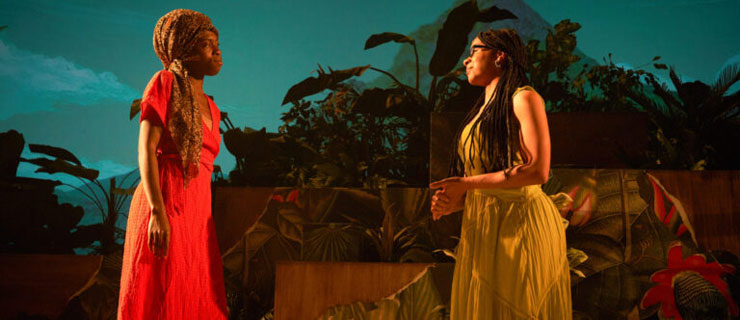
Tante Ilyana (Charlene Francois) meets Edwidge Danticat (Andrea Patterson) in a scene from Miami New Drama's production of "Create Dangerously." (Photo by FURIOSA Productions)
Create dangerously.
This is a plea to you and me. Specifically, it asks that we continue consuming and making art – even though there are those who wish to stymie our expression.

Thiana Berrick and Edson Jean as art historian Marc Miller and artist Jean-Michel Basquiat. (Photo by FURIOSA Productions)
The aforementioned plea reverberates these days from Miami New Drama (MIND). The professional theater company in Miami Beach is impressively presenting the world premiere production of “Create Dangerously” through Sunday, May 28 on Lincoln Road in the Colony Theatre
“Create Dangerously” is a touching, invigorating, and vital live theatrical piece. Its basis is Edwidge Danticat’s book, “Create Dangerously: The Immigrant Artist at Work.”
Danticat, who lives in Miami, is a Haitian-American novelist and short story writer whose first novel, “Breath, Eyes, Memory,” became an Oprah’s Book Club selection. Since that work’s publication in 1994, Danticat has received many honors and awards.
After theater artist Lileana Blain-Cruz read Danticat’s book, she felt moved to adapt the work for the stage. The finished product is not a traditional play, but a folkloric piece of storytelling. It combines music, memory, thoughts, projections, dance, stories, and direct address. In addition, it is an unapologetic, spirited celebration of Haiti and Haitian culture, a plea (described above), and a tribute to immigrants, the importance of family, community, and those who dare to create.
The characters include Danticat and Blain-Cruz, although the women themselves do not appear in the show. Instead, a talented cast of six performers presents the piece by portraying several real-life characters.
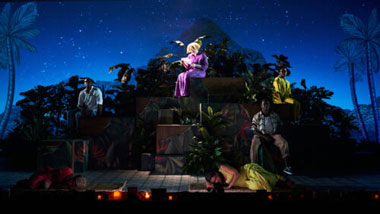
The cast takes turns playing author Edwidge Danticat. (Photo by FURIOSA Productions)
Certainly, “Create Dangerously,” like all MIND shows, reflects the diversity of Miami, specifically its large Haitian population.
Blain-Cruz’s piece begins on an energetic note, with performers entering the stage dancing and clapping to vibrant music. And, during the reviewed performance, audience members clapped along.
A shortcoming early on is that the narrator shouts out a phrase that we might assume is in Creole, and there is no translation. After the narrator repeatedly chants that phrase, “Sak pase!”, the other actors respond “Na’p boule!” multiple times without translating. It would have helped to at least include the phrases and its translations in the program if subtitles were unavailable. “Sak pase” is a Haitian Creole phrase that means “What’s up?” And “N’ap boule” means “Everything’s good.”
But there were times in Haitian history during which everything was hardly “good.” No doubt, the reign of dictator Francois “Papa Doc” Duvalier (1907-1971) caused many people to suffer. In “Create Dangerously” we learn about a chilling moment during Duvalier’s reign. Specifically, on Nov. 12, 1964, the Duvalier regime executed Marcel Numa and Louis Drouin, two Haitians who dared to fight back against Duvalier’s tyranny.
Numa and Drouin’s story is one of remarkable courage and defiance in the face of grave danger. These individuals had emigrated from Haiti to escape the Duvalier dictatorship. They settled in the United States and became “productive young immigrants in the U.S.” While in America, they joined a group called “Jeune Haiti, “or “Young Haiti.”
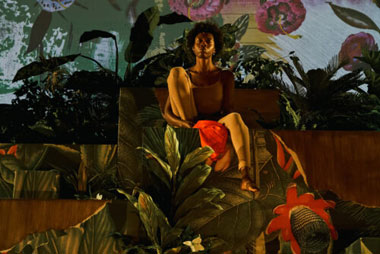
Dancer Charlene Francois poses like a figure in a Haitian painting.
“We were two of 13 Haitians who left the United States for Haiti in 1964 to engage in a guerrilla war,” Drouin tells us.
Unfortunately, Duvalier’s henchmen captured Numa while Drouin was wounded in battle. The regime’s officers “wanted to make a spectacle” of their deaths. And, so, the regime bused in hundreds, including children, to watch the execution by firing squad.
In MIND’s production, two performers solemnly portray Numa and Drouin walking to their deaths. The lights dim, while other performers gravely narrate. Storm clouds appear on a projector to reinforce the gravity of the moment. While we do not see anything graphic, Blain-Cruz’s words are unsparing and could upset the easily queasy. The playwright’s words are also powerful: The men “had abandoned comfortable life in the United States and sacrificed themselves for the homeland,” she writes in the script. “Marcel Numa and Louis Drouin were patriots who died so that other Haitians could live.”
Following the execution, some of Haiti’s residents turned to art to cope. For instance, some people tried quietly to stage a play and “there were many recurrences of this story throughout the country, book and theater clubs secretly cherishing some potentially subversive piece of literature, families burying if not burning their entire libraries, books that might seem innocent but could easily betray them. Strings of words that, uttered, written, or read, could cause a person’s death.”
Still, after the executions, “all of Haiti desperately needed art that could convince them that they would not die the same way Numa and Drouin did. They needed to be convinced that words could still be spoken, that stories could still be told and passed on.”
Unquestionably, the above words are chilling during a time of book banning, limiting what teachers can teach, and what student actors can perform.
Blain-Cruz and Danticat suggest that artists, particularly writers, can set a tone of bravery during dangerous times simply by creating work.
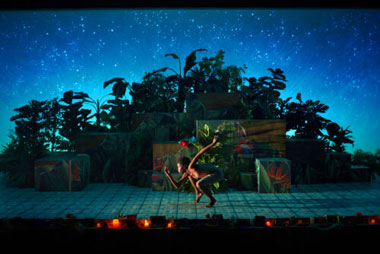
Dancer Charlene Francois moves through a Haitian landscape. (Photo by FURIOSA Productions)
Of course, that can be difficult – as grueling as, perhaps, ascending a steep mountain for several hours in the heat. In “Create Dangerously,” Blain-Cruz includes an account of Danticat and family members doing just that. They visit a distant relative who lives in the Haitian countryside atop a mountain. Obviously, Blain-Cruz included the account to stress the importance of keeping in touch with family and holding on to one’s roots.
“It’s too bad that we don’t know our family before our great grandparents,” one of Danticat’s relatives opines.
But that hours-long trek up that mountain may also symbolize the difficulty and danger of creating art under repressive conditions.
Certainly, close family members of Haitian radio journalist and human rights activist Jean Dominique knew that danger. In fact, they lived it. Blain-Cruz includes an account of the assassination, which took place on Monday, April 3, 2000. Vivid sound effects (the sound designer is Palmer Hefferan) reinforce the chaotic atmosphere during and after the assassination.
“How does J.J. (Jean’s daughter) write after having seen her father gunned down a few feet from where they worked together at his radio station?” the actor portraying Danticat asks.
And then there was Jean’s wife, Michèle Montas.
“During the months that followed Jean’s assassination, Michèle often had the impossible task of reporting on the air about the investigation into his death,” we learn.
Speaking of learning and knowledge, “Create Dangerously” enlightens us about a couple of famous Haitian artists. This section of the piece feels like an art and history appreciation course as opposed to the more dramatic sections of the stage adaptation. But Blain-Cruz, who sensitively directed the production, never allows it to become stagnant. The actors are never “talking heads.” Instead, they move as they speak, lending energy to the proceedings. In addition, upbeat music and dancing reinforces the happier, celebratory moments.
One of the evening’s more touching moments comes when the performers lay flowers at what resembles a memorial to late artists. Candles and photos rest above varied cloths downstage. As the performers add flowers to the memorial, peaceful, bright music plays. In addition, we see roses appear on the projector screen.
Hannah Wasileski designed the projections, which include a pretty and realistic-looking depiction of the mountain that Danticat and family members ascend on their way to visit a relative. For instance, the birds that appear on screen look real.
Meanwhile, Adam Rigg designed the basic set, which features a series of box-like platforms decorated with plants. The platforms allow the actors to sit or stand on different levels, ensuring variety and allowing Blain-Cruz to highlight performers.
Lighting designer Yi Zhao illuminates the stage dimly during scenes such as the one depicting the execution. For happier, celebratory scenes, the lighting is appropriately brighter.
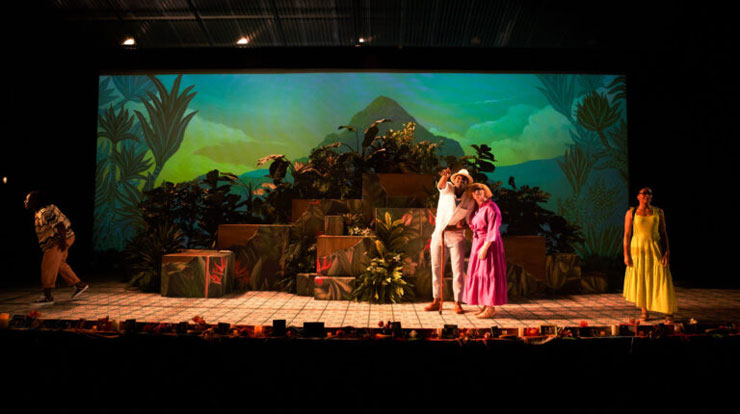
The cast of Miami New Drama's "Create Dangerously." (Photo by FURIOSA Productions)
Costume designer Montana Levi Blanco creates variety by clothing the performers in different, appealing outfits.
The performers, who play multiple roles, lend energy and spontaneity to the production. The actors are Brittany Bellizeare, Thiana Berrick, Charlene Francois, Edson Jean, Andrea Patterson, and Paul Pryce.
While “Create Dangerously” is not preachy, Blain-Cruz offers advice toward the stage adaptation’s end. It can be valuable for anybody at any time during their lives.
“So…I suppose the answer, the miraculous terrifying but necessary answer, is to not remain silent, to not cower in fear and ignorance, to not pretend to speak for anyone but yourself, to speak out, and to listen.”
Miami New Drama’s production of “Create Dangerously” continues through May 28 at the Colony Theatre, 1040 Lincoln Road in Miami Beach. Performance times are 8 p.m. Thursday through Saturday and 3 p.m. Sunday. For tickets, go to www.miaminewdrama.org or call (305) 674-1040.
 MAIN MENU
MAIN MENU

